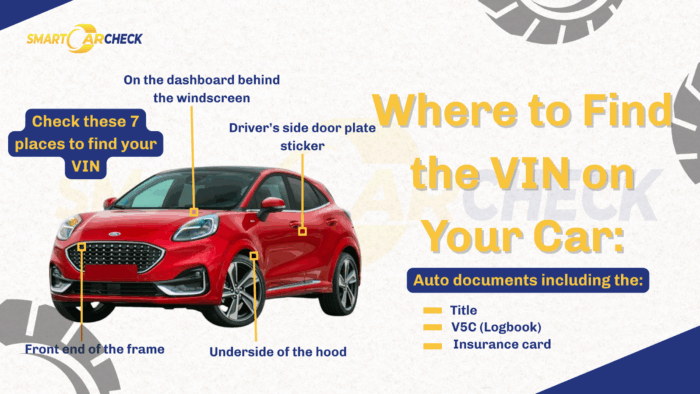Every vehicle has its own identity, just like every person has a name or a passport number. For cars, vans, motorbikes, and trucks, this identity is called the VIN number. VIN stands for Vehicle Identification Number.
A VIN is important because it tells you exactly what the vehicle is, where it came from, and if it has a safe and honest history. When you buy or sell a car, the VIN number helps you check if the vehicle is real, stolen, damaged, or has hidden problems.
Every vehicle built since 1981 must have a 17-character VIN. These characters are a mix of letters and numbers, and each one provides key information and records about the car. This makes running a VIN number check one of the most important vehicle checks when looking to buy a used vehicle.
—————————-
KEY TAKEAWAYS
- A VIN is a 17-character code that identifies a car’s make, model, year, engine, and factory, helping buyers and owners confirm its true identity.
- Checking a VIN helps spot stolen, cloned, or written-off vehicles, mileage fraud, and safety issues, keeping transactions safe and legal.
- A VIN check allows access to MOT history, recalls, build sheets, and correct parts, making ownership, maintenance, and resale easier and safer.
What Does a VIN Number Look Like?
A VIN number is always made up of 17 characters. These are a mix of numbers and capital letters. You will never see the letters I, O, or Q, because they look too much like numbers and can confuse people.
Even though a VIN number looks like a random code, every part tells a story. The 17 characters are split into three main sections:
WMI (World Manufacturer Identifier) – Characters 1 to 3
The first three characters tell you who made the vehicle and where it was built. This helps you know the country of origin and the company behind the car.
Manufacturers all over the world have special codes so people can quickly learn this information.
For example:
- “S” can mean the United Kingdom
- “1”, “4”, or “5” often mean the United States
- “W” usually means the car was made in Germany
- “J” often means Japan
- “3” can mean Mexico
This section is important because many buyers want to know if their car comes from a trusted maker or a certain country known for quality.
VDS (Vehicle Descriptor Section) – Characters 4 to 9
The next six characters explain what the vehicle is. They describe the main features of the car. This helps identify one model from another, even if they look similar on the outside.
The VDS can tell you about:
- The model (like Fiesta, Civic, or C-Class)
- The body type (hatchback, SUV, saloon, etc.)
- The engine size and type (inline-four petrol engines, V6 diesel engines, or hybrid electric systems, etc.)
- Safety features (airbags, ABS, traction control)
- Trim level (basic, mid-level, or high-spec)
- The check digit (character 9) validates the accuracy of the VIN.
Manufacturers use this part to show how the vehicle was built and what equipment it came with. This is helpful when buying used cars because you can confirm if the car truly matches the seller’s claims.
VIS (Vehicle Identifier Section) – Characters 10 to 17
The last eight characters give the vehicle’s individual identity, like a fingerprint. No two vehicles in the world share the same VIS, even if they are the same model and colour.
- The 10th character shows the model year e.g. A = 1980, B = 1981, Y = 2000, 1 = 2001 etc.
- The 11th character reveals the factory where it was made
- The 12th-17th characters make up the vehicle’s unique serial number. This is the assigned number as the vehicle rolls off the assembly line. makes it easy to differentiate between similar models.
Where Can I Find the Vehicle Identification Number (VIN)?

You can find the VIN number in many places on the vehicle and on its documents. Here are the most common places to check:
Behind the windscreen
Stand outside the car and look at the bottom corner of the windscreen on the driver’s side. Many cars show the VIN here.
Driver-side or passenger-side door frame
Open the door and look at the metal frame or the sticker inside the door. The VIN number is often printed there.
Under the bonnet
Some cars have the VIN stamped on the engine bay, on a metal plate or directly on the frame.
On the chassis
The VIN may be stamped on the chassis itself. This is very common on older vehicles and motorbikes.
Your V5C logbook
The VIN appears on the V5C registration certificate. Make sure the VIN in the logbook matches the VIN on the vehicle.
Insurance and service papers
Insurance documents, service records, and MOT paperwork also list the VIN.
What Can I Do With the VIN Number?
A VIN number gives you access to a huge amount of information. Here are the most common things you can do by checking the VIN with a VIN decoder or VIN check tool:
Check the Car’s History
Checking the VIN number helps you see a car’s full history, including past accidents, mileage issues, theft records, and previous owners. This information protects you from buying a risky vehicle, saving you money, time, and stress by showing problems the seller may not mention.
Confirm the Car’s Real Details
You can decode the VIN to confirm a car’s true make, model, year, engine, and features. This helps you catch wrong details, hidden changes, or dishonest listings. It ensures you know exactly what you’re buying before spending your money.
Check for Safety Recalls
The VIN check tool lets you look for open safety recalls that need repairs. Recalls are serious problems found by the manufacturer. Checking them helps keep you safe by showing what repairs are required, so you know if the car needs urgent attention.
Order Parts That Fit
Decoding the VIN helps mechanics and parts shops find the exact parts your car needs. It shows the right engine type, trim level, and equipment. This prevents wrong orders, avoids repair delays, and makes sure the replacement parts fit your car properly.
Report or Find a Stolen Vehicle
Police and insurance companies can run a VIN number check to track stolen cars and if your car is missing, checking the VIN helps identify it. If you’re buying a used car, a VIN check ensures it isn’t stolen, protecting you from legal trouble.
The Importance of a VIN Number Check
Checking the VIN number is one of the most important steps when buying a used vehicle. Here’s why:
You avoid stolen or cloned cars
A VIN check helps you spot cars with fake identities. Criminals sometimes copy a VIN from another vehicle to hide theft. Checking the VIN early protects you from buying a stolen or cloned car that could later be taken by police.
You can spot write-offs
A car may look fine, but it could have been written off before. A VIN check shows if it is Category A, B, S, or N. This helps you avoid unsafe vehicles and saves you from buying a car with hidden damage.
You can see mileage problems
Some sellers roll back the mileage to make a car seem newer or more valuable. A VIN check compares past readings to spot mileage fraud. This protects you from paying too much for a car that has been misrepresented.
You make sure the car matches the logbook
Checking the VIN on the car against the V5C logbook helps confirm the car is legal. If the numbers don’t match, the car may be cloned, stolen, or incorrectly recorded. This protects you from legal trouble and risky purchases.
You avoid paying too much
A VIN check shows the car’s real history, including past accidents, damage, number of owners, and use. If the car has problems, the price should be lower. This helps you negotiate better and avoid overpaying for a risky vehicle.
Sellers stay protected too
A VIN check also helps sellers. It confirms your vehicle details are correct and up to date. This prevents confusion, builds trust with buyers, and avoids delays during the sale. It also protects you from disputes about the car’s history.
It’s one of the best ways to stay safe
A VIN check is simple but very powerful. It can save you money, prevent stress, stop legal problems, and protect you from unsafe or damaged cars. It gives you confidence and helps you make a smart, safe buying decision.
VIN Number vs Chassis Number: What’s the Difference?
Many people use “VIN” and “chassis number” to mean the same thing because the VIN is stamped onto the vehicle’s chassis. This makes the chassis number seem like another name for the VIN. However, they are not always used in the same way.
The VIN is a full 17-character code that gives detailed information about the car, including its make, model, year, and features. The chassis number can refer only to the part of the VIN linked to the frame or sometimes the whole VIN itself.
Check the VIN Before Buying
A VIN number is one of the most important things to check when buying or owning a vehicle. A VIN check helps you confirm the car’s identity, avoid hidden problems, and stay safe on the road. By using the VIN the right way, you can make smarter choices, save money, and protect yourself from risky cars.
Frequently Asked Questions About VIN Number
What if the VIN is damaged or missing?
If the VIN is damaged, unclear, or missing, it can be a serious warning sign. The car may have been stolen, cloned, or tampered with. Always ask the seller for proof, and avoid the vehicle until the VIN is fully verified..
Can I change my car’s VIN?
No, you cannot legally change your car’s VIN. The VIN is a permanent identifier set by the manufacturer. Changing or removing it is illegal and can make the vehicle look stolen or cloned. If your VIN is damaged, only authorities can inspect and confirm it.
Is the VIN number on a MOT certificate?
Yes, the VIN appears on an MOT certificate along with the car’s registration, make, and model. It’s printed on the paper certificate you get after the test, and it’s also used to check the vehicle’s MOT history online using an MOT check tool.


